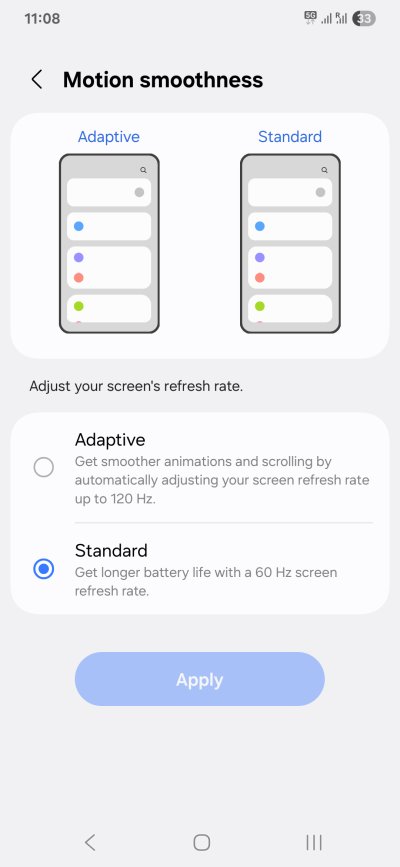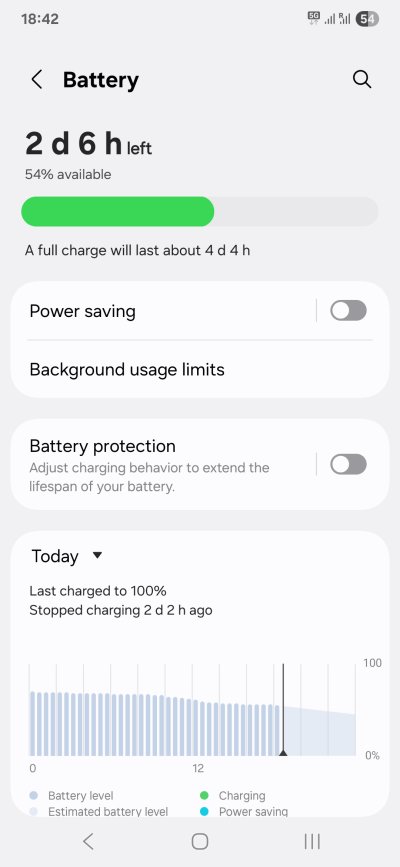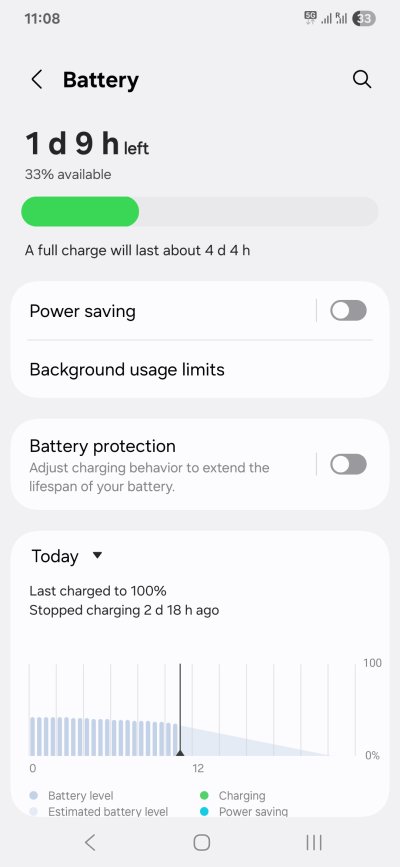Updated: August 15, 2025
Over the years, I have owned (and/or own) a variety of Android smartphones. For the most part, they all exhibited reasonably long battery time in between charges, more so than what you normally hear reported in various articles. My Motorola One Zoom could do about a week, even with several hours of video calls, video playback, music, browsing and alike. More recently, a Samsung A54 in my possession can do four days.
This latest report triggered a bunch of emails, with people asking me what kind of magic I'm using to get such results. Well, I thought, ain't it obvious? After all, if you've followed my rather long Android privacy guide, you will have already taken a lot of steps toward improved battery life. But, for the sake of completeness, let me show you what I do, how I do it, and what you can do to extend the charge time.
The basics
First, the inviolate laws of thermodynamics. The more you use your phone, the more you will bleed your battery. This is a simple fact. The only question is, for a given amount of time and patterns of usage, are there any tips or tricks you could employ to reduce the power consumption?
Well, here are the three main things - other than your actual use - that dictate battery life:
- Mobile network signal strength - the closer you are to the antenna, the lower the wattage the phone has to use to maintain a stable connection to the cell tower. If you have five bars versus say two bars, by the simple merit of spatial proximity, you will reduce the energy discharge. Since your phone needs to maintain a connection with the cell tower all the time, the difference does add up.
- 5G versus 4G - If you use 5G, you will use more battery. Simple.
- Ambient temperature - Li-ion batteries lose their capacity at lower temperatures. You can do a simple test. Use your phone when it's say 25 degrees outside, and then when it's 0 degrees outside. With the exact same usage, there will be 10-20% less juice-time available. The same problem affects electric cars, as it happens.
- Screen brightness - Most of the time, Android manages brightness automatically. It will usually increase brightness to match bright conditions, and vice versa. Thus, if you tend to use your phone in the sunlight, you will most likely use more power than if you do it at night, in a dark/badly-lit room.
- Sensors - This is a big one, and I'm going to elaborate on this a bit more.
Your phone doesn't need to be a beacon
The default smartphone is designed and configured to be noisy. If you do not change anything, your Android will have Bluetooth and Wireless enabled, Location will be turned on, and so forth. Your apps will use background data. There will be lots of data collection done, at all times.
Most Android browsers do not come with any sort of ad-blocking. In some regions, like the EU, you will have the option to choose your default browser. If you select Brave, you will have a built-in ad-blocker, or if you choose Firefox Focus, then you will have some limited form of anti-tracking. For everything else, you will need to manually set up ad-blocking, if available. Many browsers do NOT allow any extensions. Some do.
My browser of choice is Firefox, as it allows extensions, it allows the superior Manifest V2 extensions, including both UBlock Origin (UBO) and Noscript Security Suite (NSS), both of which allow you to block tons of silly and pointless "modern" Web annoyances, including ads and trackers.
So, if you want to reduce your battery usage, then:
- Install a superior browser, like Firefox + UBO. This will significantly reduce your exposure to stupid ads, reduce bandwidth usage as you don't need to load ads, reduce CPU usage for the same reason, reduce your chance of being hit by malware (linked or loaded through malicious ads, as has happened before), improve your privacy, and make your browsing faster, quieter. Win win win win win.
- Disable sensors you don't need. For example, I don't use enable Wireless unless I am going to actively connect to an access point. I always disable Bluetooth, as I hate the notion of paired devices, especially over-expensive "buds" and similar nonsense. I always keep Location off, except when I need to navigate, and only allow it for specific apps, like say Here WeGo.
- Disable background data. Except messaging apps and maybe your weather app, maybe, you don't really need anything "refreshing" in the background. For the most part, the constant background use is a waste of power and network data.
- Disable any sort of diagnostics, telemetry, etc - wherever available.
- Uninstall apps you don't need - if they aren't on your device, they won't run, they won't be updated. Less data, less power. Quick maffs.
Additional tweaks - refresh rate, animations, transparency
There are still more tricks you can try. These will not only improve power usage, these will also improve the device performance and responsiveness. Much like disabling animations in Fedora or Compositor in Plasma X11 helps with speed. In particular, I invite you to check the second article linked in the previous sentence, to see a desktop program rendering with and without compositing. You will see the exact same result in your Android.
Please note not all of these options may or will be available on your phone, and they may also be tucked away in different parts of Settings. For me, with Android 15 on my Samsung A54, the workflow be as follows:
Animations, transparency & blur
Go to Accessibility > Vision enhancements. Here, toggle on reduce animations and/or reduce transparency and blur. If you do so, you will instantly see an improvement in your overall device's responsiveness. Apps and menus will open instantly when you swipe. There won't be any unnecessary fancy visual effects.

Another bonus is, this can protect you against various "malicious tap" apps, although, from a security perspective, the issue is totally overblown. Why? Because you first need to install some malicious app for it to act maliciously. Duh. Don't do it, problem solved. Don't install pointless apps. Just don't.
The downside is you won't see certain actions. For example, if you take a screenshot, there's no visual clue you've done so (animations only), unless your phone comes with the screenshot post-edit nonsense, and you haven't disabled this (if possible, that is). You will still have system sounds, so there will be an indicator of your actions, though.
Motion smoothness (refresh rate)
Under Display, tap Motion smoothness. This allows you to change your refresh rate. Adaptive means you will get smoother animations and scrolling. But we've just disabled those, plus I'm not interested in gimmicks, and I don't care about "big" numbers as an indicator of awesomeness. 60 Hz is okay unless you play certain games, but then, mobile, games, nope. I choose Standard, which uses a fixed 60 Hz screen rate. Even the menu tells you: longer battery life. Yup.

Results
So what gives? Well, my Samsung A54 shows about 4 days and change for my typical usage pattern. That translates to about 1-2 hours of browsing per day, some messaging, some light use of other apps, about half an hour of music. If I turn on Battery Saver (which throttles CPU to 70%, turns 5G off, and uses dark theme), then I gain another half a day or so. The dark theme element is optional, and it does not drastically affect the outcome.


The improvement breakdown
Okay, so let's assume for a moment that 2 days is the nominal, default battery life for a healthy cell. This is indeed what the device reported early on before my rigorous tweaking and improvements. So, the actions mentioned above will give you the following (very rough estimate):
- Sensors & data - about 20-30%.
- Browser choice + adblocking - about 20-30%.
- Screen refresh rate - about 10-15%.
- Animations, transparency - about 10%.
- All other tweaks (apps, diagnostics and such) - about 15%.
Please don't go off firing emails explaining how my numbers don't add up and all that. I've not dedicated my life to Android power management studies. My data above stems from casual observations over the past year or two with this device. Of course, if you happen to spend more time browsing or watching videos, you will obviously bleed more juice.
The idea is that these improvements are relative to the DEFAULT configuration. In other words, if you were to use other browsers, or not disable any sensors, or not reduce background data and alike, then you will see a reduction in your estimated battery time. My tweaks don't render miracles. They merely make pointless defaults less pointless. Got it?
Conclusion
Hopefully, you are now a bit wiser when it comes to Android and power than you were ere you set on reading this piece. Your actual charging patterns will inevitably follow your usage patterns. There will also be an element of luck involved, like your signal strength or weather conditions. But there are lots of ways you can improve your battery life, alongside significant boosts in privacy, responsiveness and peace of mind. You really won't lose anything if you apply a bit of spartan utilization unto your phone.
Long term, you will also save money. Phone batteries have limited lifetime, usually determined by assembly quality and the number of charging cycles. Thus, if a battery can survive say 500 cycles, there's a big difference whether you do it once every 2 days or once every 4 or 5 or 7 days. With modern phones, for the most part, which are made with non-removable batteries, all of this eventually translates to hard cash. You may be "forced" to replace your device sooner, if its battery depletes too much, and you don't want to fiddle with repairs or replacements. So, having extended time between charges means longer device usage, less frequent purchases, more money in your pocket. Really, when you combine everything, from ads to privacy to noise to speed to your finances, it's all one big win. And now we must retire and recharge our brain cycles.
Cheers.